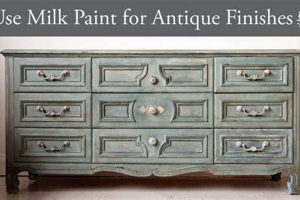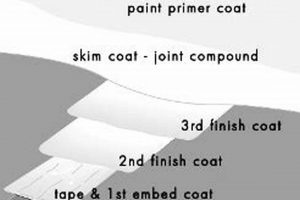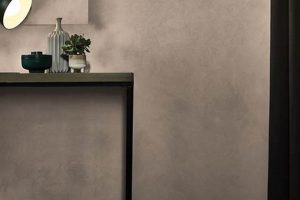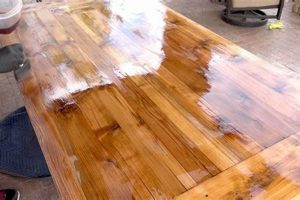Selecting an optimal coating for an exterior entrance is a crucial decision impacting both aesthetics and longevity. This choice influences the visual appeal of a home’s facade and provides essential protection against weather elements. An example would be a high-gloss enamel chosen to withstand frequent cleaning and provide a vibrant color that makes the entrance stand out.
The selection of a durable and attractive coating significantly enhances curb appeal, potentially increasing property value. Historically, the coatings used on entryways were simple paints offering minimal protection. Modern formulations offer improved resistance to fading, chipping, and mildew, extending the lifespan of the entryway and reducing maintenance requirements.
Understanding the various types of coatings available, their specific properties, and appropriate application techniques is essential for achieving a desirable and long-lasting result. The subsequent sections will explore these considerations in detail, providing a guide to informed decision-making.
Coatings Advice for Exterior Entryways
Properly coating an exterior entryway enhances both its visual appeal and protective qualities. The following advice provides guidance for selecting and applying the most suitable solution.
Tip 1: Surface Preparation is Paramount: Prior to coating, the surface must be thoroughly cleaned, sanded, and primed. This ensures proper adhesion and a smooth, uniform appearance. For example, remove any peeling paint or debris and use a quality primer appropriate for the surface material.
Tip 2: Select a High-Quality Product: Opt for exterior-grade products formulated for durability and weather resistance. Cheap paints tend to fade and degrade quickly, leading to frequent reapplication. A premium acrylic latex enamel, for example, offers superior longevity.
Tip 3: Consider Climate and Sun Exposure: Intense sunlight and extreme weather conditions necessitate coatings with UV protection and moisture resistance. In humid climates, choose options with mildew inhibitors. In areas with high sun exposure, consider lighter colors that reflect more light and heat.
Tip 4: Application Technique Matters: Employ proper brushing or spraying techniques to achieve an even and consistent layer. Multiple thin layers are preferable to a single thick one, reducing the risk of drips and uneven drying. For instance, using a high-quality brush and applying even strokes will contribute to a professional finish.
Tip 5: Understand the Sheen Level: Sheen affects both the aesthetic and functional properties. Higher sheens are easier to clean but highlight imperfections. Lower sheens are more forgiving but may be less durable. Semi-gloss or gloss finishes are generally recommended for exterior entryways because of their durability and ease of cleaning.
Tip 6: Re-coat Periodically: Even with high-quality products, periodic reapplication is necessary to maintain protection and appearance. Regular inspection and maintenance prevent deterioration and extend the lifespan. Depending on environmental factors, re-coat every 3-5 years.
Tip 7: Read Manufacturer’s Instructions: Always adhere to the manufacturer’s guidelines for surface preparation, application, drying times, and cleanup. Following these instructions precisely will optimize the outcome and longevity of the coating.
Adhering to these tips will result in a durable, attractive, and long-lasting coating that enhances the overall appeal and protection of the entryway.
The following section will delve into specific types of coatings and their suitability for various applications.
1. Durability
Durability is paramount when considering coating options for exterior entryways. The exposure to environmental stressors necessitates a selection that withstands wear and tear, maintaining both aesthetic appeal and protective functionality over an extended period.
- Resistance to Abrasion
Entryways are subject to frequent contact, from keys and packages to general foot traffic. A durable coating resists scratches and abrasions, preserving the surface’s integrity and appearance. Polyurethane-based enamels, for example, offer superior abrasion resistance compared to standard latex paints. This translates to a longer lifespan and reduced maintenance costs.
- Weatherability
Exposure to fluctuating temperatures, precipitation, and ultraviolet radiation can degrade many coatings. A durable coating maintains its color and adhesion despite these conditions, preventing peeling, cracking, and fading. Acrylic latex formulations with UV inhibitors are specifically engineered to withstand the elements, making them suitable for exterior applications.
- Impact Resistance
Entryways may be subject to accidental impacts. A durable coating resists chipping and denting, maintaining the structural integrity of the surface. High-solids epoxy coatings, for example, offer superior impact resistance compared to thinner, less robust formulations.
- Resistance to Moisture
Moisture penetration can lead to wood rot, corrosion, and coating failure. A durable coating provides a barrier against moisture, protecting the underlying substrate. Oil-based primers, followed by a topcoat of moisture-resistant enamel, provide an effective defense against water damage.
The durability of an exterior entryway’s coating is directly linked to its long-term performance and aesthetic value. Selecting a formulation that effectively addresses the aforementioned factors ensures that the entryway remains attractive and well-protected, minimizing maintenance requirements and extending its service life. Therefore, prioritizing durability in coating selection is a critical component of responsible home maintenance.
2. Aesthetics
The aesthetic considerations surrounding exterior entryway coating selection are pivotal in establishing a home’s character and conveying its visual identity. The chosen coating directly influences curb appeal and contributes significantly to the overall architectural harmony of the residence.
- Color Palette and Architectural Style
The color chosen should complement the architectural style of the house and its surrounding landscape. A Victorian home might benefit from a rich, historical color, while a modern residence might call for a minimalist, neutral tone. The coating selected impacts the perceived style and age of the house, influencing its visual impact.
- Sheen Level and Light Reflection
The sheen of the coatingranging from matte to high glossaffects how light is reflected and perceived. Higher gloss levels create a vibrant, attention-grabbing appearance, while matte finishes offer a more subdued and elegant aesthetic. The appropriate sheen level should be chosen based on the desired visual effect and the degree to which imperfections should be concealed.
- Coating Texture and Surface Detailing
The texture of the coating, whether smooth or subtly textured, can add depth and visual interest. Coatings can be applied to accentuate architectural details or create a specific visual effect, contributing to the overall aesthetic composition of the entryway. Textured finishes are often used to mimic the appearance of natural materials or to provide added grip.
- Maintenance and Long-Term Appearance
The long-term aesthetic appeal of the coating depends on its ability to resist fading, chalking, and mildew growth. Coatings formulated with UV inhibitors and mildewcides maintain their color and appearance over time, reducing the need for frequent reapplication and preserving the entryway’s visual appeal. Regular cleaning and maintenance are also essential for preserving the long-term aesthetics.
The aesthetic dimensions of coating selection extend beyond mere surface appearance; they encompass the interplay of color, sheen, texture, and durability to create a cohesive and visually appealing entryway. A thoughtful selection process, considering these interconnected elements, culminates in an entryway that complements the home’s architecture and reflects the homeowner’s personal style.
3. Weather Resistance
Weather resistance is a critical component in determining the efficacy of a coating on an exterior entryway. Environmental elements, including precipitation, solar radiation, and temperature fluctuations, exert constant stress on the surface. A coating lacking adequate weather resistance will degrade rapidly, resulting in aesthetic decline and compromised protection of the underlying material. For example, exposure to ultraviolet (UV) radiation causes many coatings to fade or chalk, diminishing their visual appeal. Similarly, repeated cycles of freezing and thawing can lead to cracking and peeling, especially in areas with high moisture levels. The choice of coating, therefore, hinges on its ability to withstand these forces.
Specific coating formulations address weather-related challenges. Acrylic latex coatings, known for their flexibility and UV resistance, are often preferred for regions with intense sunlight. Oil-based coatings provide enhanced water resistance, making them suitable for areas prone to heavy rainfall. Furthermore, the addition of mildewcides is crucial in humid climates to prevent the growth of mold and mildew on the coated surface. Real-world applications demonstrate the significance of this selection; a poorly chosen coating on a north-facing entryway in a temperate zone may exhibit mildew within a year, while a weather-resistant coating might last for several years without requiring significant maintenance.
Ultimately, selecting a coating that provides robust weather resistance is an investment in the long-term integrity and appearance of an exterior entryway. The interplay between environmental factors and coating properties necessitates a thorough understanding of regional climate patterns and the specific characteristics of various coating formulations. The absence of this understanding can lead to premature failure and costly repairs, underscoring the importance of weather resistance as a pivotal element in selecting the most appropriate coating.
4. Ease of Cleaning
The property of ease of cleaning holds significant relevance in the selection of an optimal coating for exterior entryways. This characteristic impacts long-term maintenance costs and the sustained aesthetic appeal of the entrance. Coatings that readily accumulate dirt, grime, and environmental pollutants necessitate frequent cleaning, increasing the time and resources required for upkeep.
- Surface Texture and Cleanability
The texture of a coating directly influences its cleanability. Smooth, non-porous surfaces are easier to clean than rough or textured surfaces, which can trap dirt and debris. High-gloss and semi-gloss finishes generally offer superior cleanability compared to matte or eggshell finishes. For instance, a smooth enamel finish can be wiped clean with a damp cloth, while a textured finish may require scrubbing with a brush.
- Resistance to Staining and Dirt Accumulation
Coatings vary in their resistance to staining from common environmental contaminants, such as bird droppings, pollen, and road grime. Coatings formulated with stain-resistant properties reduce the likelihood of permanent discoloration and facilitate easier cleaning. Some acrylic latex paints incorporate hydrophobic properties that repel water and dirt, minimizing accumulation.
- Durability of Coating During Cleaning
Frequent cleaning can gradually degrade a coating, especially if harsh chemicals or abrasive cleaning methods are used. A durable coating withstands repeated cleaning without losing its color, sheen, or protective properties. High-quality exterior-grade coatings are formulated to resist the effects of cleaning agents, ensuring long-term performance and aesthetic appeal.
- Impact of Sheen on Visibility of Dirt
The sheen of a coating influences the visibility of dirt and grime. While high-gloss finishes are easier to clean, they also tend to highlight imperfections and dirt particles. Lower-sheen finishes, such as satin or eggshell, are more forgiving in concealing minor imperfections but may require more effort to clean. Striking a balance between cleanability and aesthetic considerations is crucial in selecting an appropriate coating.
The integration of ease of cleaning as a selection criterion results in lower maintenance requirements and a sustained aesthetic value for the exterior entryway. The choice of coating, therefore, should reflect a careful assessment of surface texture, stain resistance, durability during cleaning, and the impact of sheen on dirt visibility. Ultimately, prioritizing ease of cleaning contributes to a more manageable and visually appealing entryway.
5. Surface Material
The composition of the entryway’s surface material is a primary determinant in selecting an appropriate coating. The inherent properties of the material dictate the necessary preparation, primer selection, and the type of coating that will ensure optimal adhesion, durability, and aesthetic performance. Failure to account for the surface material can lead to premature coating failure, resulting in wasted resources and compromised protection.
- Wood Type and Preparation
Different wood species exhibit varying levels of porosity and resin content, influencing coating adhesion. Softwoods, like pine, require thorough sealing to prevent resin bleed-through, while hardwoods, like oak, may necessitate grain filling for a smooth finish. Proper sanding and priming are essential to create a uniform surface for coating application. For instance, a knotty pine entryway requires a stain-blocking primer to prevent discoloration of the topcoat.
- Metal Composition and Corrosion Resistance
Metal entryways, whether steel or aluminum, require coatings that provide corrosion protection. Steel is prone to rust, necessitating a rust-inhibiting primer and a durable topcoat. Aluminum, while more corrosion-resistant, benefits from etching and a self-etching primer to ensure proper adhesion. In coastal environments, coatings with enhanced salt spray resistance are crucial to prevent degradation.
- Fiberglass and Composite Materials
Fiberglass and composite entryways offer advantages in terms of durability and weather resistance, but they require specific coating considerations. These materials typically have a smooth, non-porous surface, necessitating a bonding primer to promote adhesion. Coatings designed for use on plastics and composites are formulated to flex with the material, preventing cracking and peeling.
- Existing Coating Condition and Compatibility
When recoating an entryway, the condition and type of the existing coating must be assessed. Loose or peeling coating must be removed, and the surface properly prepared. Compatibility between the existing coating and the new coating is essential to prevent adhesion problems or chemical reactions. A test patch is recommended to ensure compatibility before applying the new coating to the entire surface.
The interplay between surface material and coating properties underscores the importance of informed decision-making. A coating that performs optimally on one material may be entirely unsuitable for another. Therefore, a thorough understanding of the entryway’s surface material and its specific requirements is paramount in selecting a coating that provides long-lasting protection, aesthetic appeal, and minimal maintenance.
Frequently Asked Questions
This section addresses common inquiries regarding the selection and application of coatings for exterior entryways. The information presented aims to provide clarity and guidance for informed decision-making.
Question 1: What coating sheen is generally recommended for an exterior entryway?
Semi-gloss or gloss sheens are generally recommended due to their enhanced durability and ease of cleaning. Higher sheens are more resistant to dirt and moisture but may accentuate imperfections on the surface.
Question 2: How often should an exterior entryway coating be reapplied?
The frequency of reapplication depends on environmental factors and the quality of the coating. Generally, recoating every 3-5 years is recommended to maintain protection and appearance.
Question 3: Is priming necessary before coating an exterior entryway?
Priming is essential for proper adhesion and a uniform finish. The primer should be selected based on the surface material and the type of coating being applied.
Question 4: What type of coating is best for an entryway exposed to direct sunlight?
Acrylic latex coatings with UV inhibitors are recommended for entryways exposed to direct sunlight. These coatings resist fading, chalking, and degradation caused by ultraviolet radiation.
Question 5: How should an entryway be prepared before coating?
Proper preparation involves cleaning the surface, removing any loose or peeling coating, sanding to create a smooth surface, and applying an appropriate primer.
Question 6: What should be considered when coating a metal entryway?
Metal entryways require a rust-inhibiting primer and a durable topcoat. Proper preparation, including cleaning and etching the surface, is crucial for adhesion and corrosion prevention.
Selecting the correct coating for an entryway involves considering various factors such as sheen, durability, weather resistance, and surface material. Proper preparation and application techniques are essential for a long-lasting and visually appealing result.
The following section will summarize the key considerations discussed and provide a comprehensive guide to the selection process.
Concluding Remarks
The preceding analysis underscores the multifaceted nature of selecting the best paint finish for front door applications. Durability, aesthetics, weather resistance, ease of cleaning, and surface material compatibility have been examined as critical determinants in achieving an optimal outcome. The interplay between these factors dictates the long-term performance and visual appeal of the entryway, influencing property value and curb appeal.
A well-informed decision, guided by a thorough understanding of these principles, ensures lasting protection and enhances the architectural character of the residence. Prioritizing quality materials and meticulous application techniques represents a worthwhile investment, safeguarding the entryway against environmental stressors and preserving its aesthetic integrity for years to come. Responsible selection therefore elevates the entrance from a mere functional element to a statement of enduring quality.







